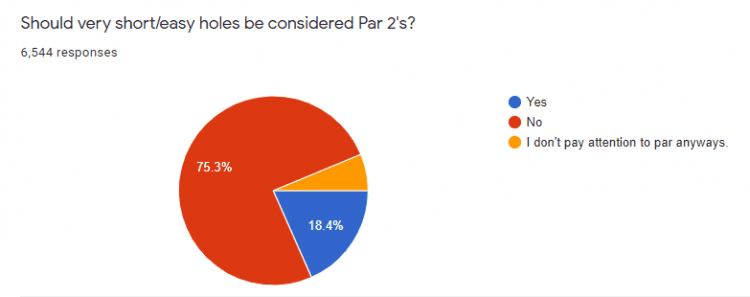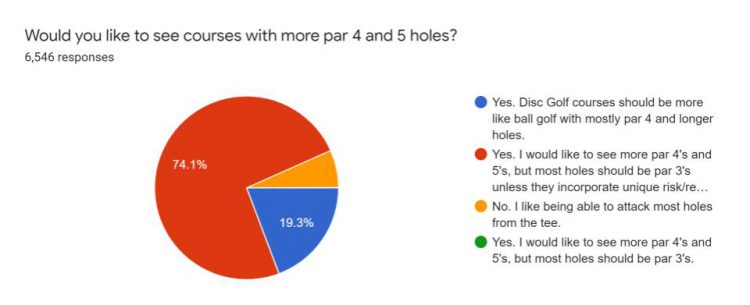2019 State of Disc Golf–Par for the Course…Literally

Today we are tackling a subject in disc golf that some consider controversial while others consider it just silly. Today we are talking about par. How should we determine par? Should we adopt par 2s in disc golf? Lots of disc golfers have their opinions on this subject, but in the end, does any of it even matter? In doing some research for this post, I found a well written article from our friend Steve Dodge that I will likely refer to a few times today. So what is par exactly?
Par in Ball Golf vs Par in Disc Golf
A quick google search for the definition of the word “par” in golf will yield this definition: “the number of strokes a first-class player should normally require for a particular hole or course.” Another explanation I found said that par is how many strokes an expert golfer should take to complete a hole.
The idea of par and using par as a way to define our scores in disc golf (1 under par, 2 over par, etc.) can be directly traced back to our ball golf roots. But something we might be forgetting is that par in ball golf should reflect what first-class or expert golfers are scoring, not the field at large.
This is why on the PGA tour we see scores close to par or maybe even as low as around 10-under par winning four day, four round tournaments. So why is it that for tournaments with the same number of holes on the PDGA National Tour and the DGPT we are seeing disc golfers needing to score close to 40-under par in order to win the event?
One line of thinking that I tend to agree with is that it’s all about putting. Steve Dodge explains, “In golf, the average number of putts is theoretically two…In golf, par is the number of shots to reach the green + putts (2).” So how does this translate to disc golf? “In disc golf, the average number of putts is theoretically one…In disc golf, par would be the number of shots to reach the green + putts (1). This would make about half of our holes into par 2s.”
Par 2 in Disc Golf?
While some of us may average 2 putts from inside the circle, our first-class and expert disc golfers for whom par should be determined (if we follow ball golf’s model) are nearly automatic from inside the circle. But in ball golf, even the best putters in the game will miss putts from inside 10 feet from time to time. That is just the difference between our two games.
So ball golf and disc golf are different in scoring. Another way to phrase that is ball golf is harder than disc golf, which is something we all like about disc golf. But since disc golf is easier shouldn’t par then be adjusted to account for this? The quickest way to account for this is the adoption of par 2s in disc golf.
This brings us to our first bit of data from the State of Disc Golf Survey. We asked survey takers if they would like to see very short or easy holes be considered par 2? The answers were pretty telling:

For the most part, we disc golfers don’t want to see par 2s out on the course. But some, especially those who are new to disc golf or unfamiliar with our culture, may be confused or surprised by this. Why would those within the sport not want to see more accurate par ratings on their courses?
Steve Dodge shed some light here again: “Setting a par 2 makes the scoring expectation much harder and, oddly enough, decreases our enjoyment of playing the game. Disc golf has a tremendous advantage in that it is more fun to play because our par score is easier to attain.” That last statement is interesting, claiming that disc golf is more fun because the par score is easier. But as we discussed earlier, a 10 ft putt in disc golf is easier than a 10 ft putt in golf, regardless of the hole’s par.
This makes me think that we have a bit of a blind spot here because we have come to expect extremely low par scores in our sport. How would you feel if you shot 10-under par at your local course and then someone came along and told you that your score was actually 1-over par if your course par was rated more accurately? But if that round had always been considered a 1-over par round, you wouldn’t care as much right?
Like when I go out and play ball golf, I know that par is pretty well out of reach. So I am pretty pleased if I score a few strokes over par.
It is all about expectation, and we in disc golf have come to expect very low scores relative to par, and as we can see in the above chart, most of us don’t care that some of our par 3 holes should be rated as par 2 if we adopted more accurate par ratings.
More Par 4 and 5 in Disc Golf?
Now what about the other end of the spectrum? What about longer and more challenging holes? We asked survey takers if they would like to see more courses with par 4 and par 5 holes. Here are the results:

So once again, we see a clear answer–we want more par 4 and par 5 holes. But as we could see from our first question about par 2s, we don’t seem to care about the accuracy of our par ratings. So do we want more par 4 and par 5 holes just because we view them as an opportunity for more birdies?
When discussing a long disc golf hole and whether it should be considered a par 3 or 4, more than once I have heard someone arguing that it should be a par 4 say something like, “Well, if it were a par 3, then it would be almost impossible to birdie.” In disc golf, we expect to get our birdies, and sometimes we expect every hole to be birdie-able. And we expect birdies not just for the first-class and expert golfers, but for your average casual players as well.
